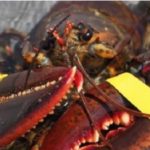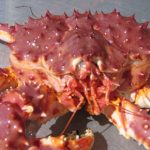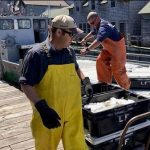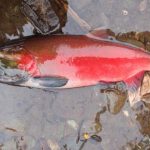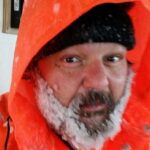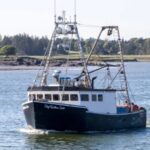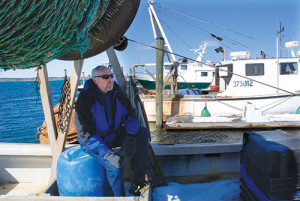Monthly Archives: September 2016
Skipper fined $25k for fishing in Wade Doaks Poor Knights Islands private playground
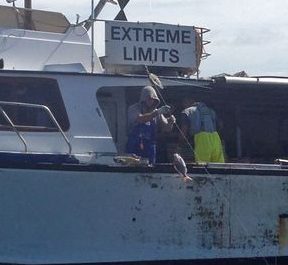 An ocean conservationist instrumental in setting up the Poor Knights Islands marine reserve has welcomed the more than $25,000 fines and costs imposed on a commercial fisherman caught fishing in the prohibited area. Wade Doak said the sentencing of Ty Thomas McQuarrie in the Whangarei District Court on Friday vindicated Northlanders who over the years have been concerned about fishing in the area which resulted in a near-depletion of fish stocks. McQuarrie, 26, of Kaitaia admitted to one charge of being a commercial fisherman who took fish by long line within one nautical mile from the mean high water mark of the reserve. McQuarrie was the skipper of Extreme Limits, a commercial fishing vessel using bottom longlining. The vessel is owned by Wild Fish (NZ). Conservationist Wade Doak said: “One episode like that shows what [would happen] if it was not severely policed.” Read the story here 13:07
An ocean conservationist instrumental in setting up the Poor Knights Islands marine reserve has welcomed the more than $25,000 fines and costs imposed on a commercial fisherman caught fishing in the prohibited area. Wade Doak said the sentencing of Ty Thomas McQuarrie in the Whangarei District Court on Friday vindicated Northlanders who over the years have been concerned about fishing in the area which resulted in a near-depletion of fish stocks. McQuarrie, 26, of Kaitaia admitted to one charge of being a commercial fisherman who took fish by long line within one nautical mile from the mean high water mark of the reserve. McQuarrie was the skipper of Extreme Limits, a commercial fishing vessel using bottom longlining. The vessel is owned by Wild Fish (NZ). Conservationist Wade Doak said: “One episode like that shows what [would happen] if it was not severely policed.” Read the story here 13:07

At Point Judith, Capturing The Fishing Industry’s Past and Present
Fishermen and industry advocates say there’s a real hunger among people to learn more about how fishermen do what they do. That’s why they’re planning to install interpretive signs around the fishing docks at Point Judith to answer people’s questions. “Those signs will speak to the variety of seafood landed in this port, some of the methods that fishermen use to catch that seafood, and all the support businesses,” said Sarah Schumann, one of the project organizers. Those support businesses include seafood processors and the bait and fuel industries at Point Judith. The Point Judith fishing port is considered the top port along the eastern seaboard for landing squid, adds Captain Rodman Sykes, who has been fishing for nearly 50 years. “I don’t think a lot of people realize that so much happens right in this little neighborhood we’ve got here and to be able to explain it to them better would be a help,” said Sykes. Audio, Read the rest here 12:17
WWF calls for suspension of commercial tuna fishing
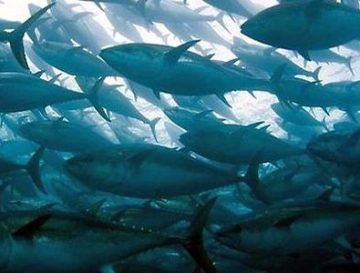 WWF is calling for the immediate suspension of commercial fishing of the Pacific bluefin tuna stock which it says is teetering on the edge of collapse due to what it calls the repeated inaction of responsible bodies. It said that the call follows another failure to agree on an urgently needed recovery plan to save bluefin tuna by Members of the Northern Committee (NC) of the Western and Central Pacific Fisheries Commission (WCPFC). Dr Aiko Yamauchi, the leader of the Oceans and Seafood Group, WWF Japan said: “This is the only way to end overfishing, and to provide hope for a future recovery of the stock. Read the rest here 11:33
WWF is calling for the immediate suspension of commercial fishing of the Pacific bluefin tuna stock which it says is teetering on the edge of collapse due to what it calls the repeated inaction of responsible bodies. It said that the call follows another failure to agree on an urgently needed recovery plan to save bluefin tuna by Members of the Northern Committee (NC) of the Western and Central Pacific Fisheries Commission (WCPFC). Dr Aiko Yamauchi, the leader of the Oceans and Seafood Group, WWF Japan said: “This is the only way to end overfishing, and to provide hope for a future recovery of the stock. Read the rest here 11:33
Fishing rights restored in changes to marine parks in Queensland and Western Australia
 Commercial fishing rights will be reinstated, conservation zones expanded and new limits put on oil and gas exploration following a review of the controversial federal network of marine parks. Fishing rights will be restored principally in Queensland and Western Australia for commercial and recreational fishers, potentially saving millions of dollars in compensation. But after a long review Australia’s world-leading network of marine-protected areas remains largely intact. Fishing groups had complained about the process which led to the creation of the protected areas, claiming it had not been “science based”. But two reviews released yesterday found there had been good consultation on the original proposes and a sound scientific base to the reserve network. Read the rest here 10:56
Commercial fishing rights will be reinstated, conservation zones expanded and new limits put on oil and gas exploration following a review of the controversial federal network of marine parks. Fishing rights will be restored principally in Queensland and Western Australia for commercial and recreational fishers, potentially saving millions of dollars in compensation. But after a long review Australia’s world-leading network of marine-protected areas remains largely intact. Fishing groups had complained about the process which led to the creation of the protected areas, claiming it had not been “science based”. But two reviews released yesterday found there had been good consultation on the original proposes and a sound scientific base to the reserve network. Read the rest here 10:56
Grieg Aquaculture in Placentia Bay: Letter: Please rethink salmon aquaculture project, Scott Roloson
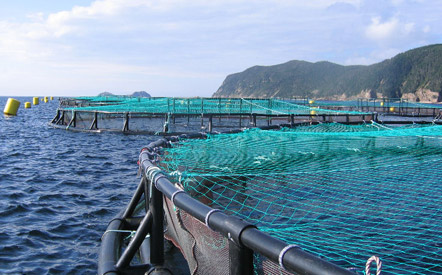 The province of Newfoundland and Labrador is among the last wild Atlantic salmon frontiers in North America. Newfoundland and Labrador possesses over 60 per cent of North American salmon rivers. We believe that the long-term socioeconomic value of recreational and First Nations’ food and ceremonial salmon fisheries are being overlooked. The recreational fishery contributes over $27 million to the province per year. Considering the Atlantic salmon is an economic driver and a symbolic icon of Newfoundland and Labrador culture, it would be imprudent to approve any aquaculture development without thorough regulatory and scientific review.,, In addition to the direct effect of genetic contamination, sea cage aquaculture also poses an unacceptable risk of disease transmission to wild fish migrating in the vicinity of cage sites. We believe that the proponent of this project has merely paid lip service to the real, impending ecological consequences of this development. Read the letter here 10:25
The province of Newfoundland and Labrador is among the last wild Atlantic salmon frontiers in North America. Newfoundland and Labrador possesses over 60 per cent of North American salmon rivers. We believe that the long-term socioeconomic value of recreational and First Nations’ food and ceremonial salmon fisheries are being overlooked. The recreational fishery contributes over $27 million to the province per year. Considering the Atlantic salmon is an economic driver and a symbolic icon of Newfoundland and Labrador culture, it would be imprudent to approve any aquaculture development without thorough regulatory and scientific review.,, In addition to the direct effect of genetic contamination, sea cage aquaculture also poses an unacceptable risk of disease transmission to wild fish migrating in the vicinity of cage sites. We believe that the proponent of this project has merely paid lip service to the real, impending ecological consequences of this development. Read the letter here 10:25
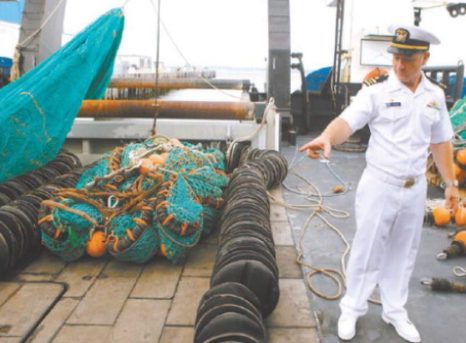
NOAA ship Bigelow back after extensive trip
A team of scientists that just completed a 54-day trip at sea aboard the 209-foot National Oceanic and Atmospheric Administration research vessel Henry B. Bigelow, which was welcomed back home Friday at a ceremony that featured U.S. Sen. Jack Reed, D-R.I.; Rear Adm. Anita Lopez, deputy director for operations in NOAA’s Office of Marine and Aviation Operations; and Lt. Cmdr. Jeffrey Taylor, Bigelow’s commanding officer, as the speakers.,, “We were collecting visual sightings of whales, dolphins, porpoises, seals, turtles, sea birds and larger fish that come to the surface, like tuna,” Palka said about the recent journey.,, The ship’s next mission will be an autumn bottom trawl survey that begins the day after Labor Day and will mean 70 days at sea, bringing up ground fish such as flounder, fluke, cod, halibut, haddock and other species for study. Besides the 16 crew members, there will be 17 scientists on the voyage. Read the story here 10:00
The latest on Post-Tropical Cyclone Hermine – Gradual weakening is forecast to begin by Tuesday morning
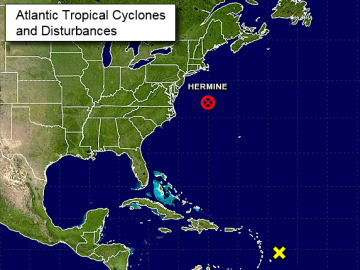 At 800 AM AST (1200 UTC), the center of Post-Tropical Cyclone Hermine was located near latitude 37.9 North, longitude 68.3 West. The post-tropical cyclone is drifting toward the north near 3 mph (6 km/h). A gradual turn toward the north-northwest and northwest is expected to occur this afternoon and tonight. A northeastward motion is expected to begin by Tuesday night. On the forecast track, the center of Hermine will meander slowly offshore of the mid-Atlantic coast for the next couple of days. Maximum sustained winds are near 70 mph (110 km/h) with higher gusts. Hermine should remain near hurricane strength through tonight. Gradual weakening is forecast to begin by Tuesday morning. Tropical-storm-force winds extend outward up to 230 miles (370 km) from the center. The estimated minimum central pressure is 997 mb (29.44 inches). Read the rest here 09:28
At 800 AM AST (1200 UTC), the center of Post-Tropical Cyclone Hermine was located near latitude 37.9 North, longitude 68.3 West. The post-tropical cyclone is drifting toward the north near 3 mph (6 km/h). A gradual turn toward the north-northwest and northwest is expected to occur this afternoon and tonight. A northeastward motion is expected to begin by Tuesday night. On the forecast track, the center of Hermine will meander slowly offshore of the mid-Atlantic coast for the next couple of days. Maximum sustained winds are near 70 mph (110 km/h) with higher gusts. Hermine should remain near hurricane strength through tonight. Gradual weakening is forecast to begin by Tuesday morning. Tropical-storm-force winds extend outward up to 230 miles (370 km) from the center. The estimated minimum central pressure is 997 mb (29.44 inches). Read the rest here 09:28
Larry the lobster strips for the camera.
 Christa Sandall knows lobsters. As an interpreter at the Bonne Bay Marine Station in Norris Point, she spends a lot of time with the animals in the tanks and she knows when they’re acting unusual. So when she saw resident crustacean Larry the Lobster “pacing around his tank,” she knew something was up. “In each lobster tank, they have a little house and usually they’re hid right under there. But he was out kinda pacing back and forth in his tank. Actually it looked like he was doing a little dance or something like that, ” Sandall said. “That’s when I noticed his carapace, his kinda shell, had lifted off a little bit.” Sandall says most lobsters moult every one to two years as they grow larger. But witnessing it for yourself is actually pretty rare — unless of course the lobster lives at your work place in a glass tank. Watch the video, read the rest here 08:45
Christa Sandall knows lobsters. As an interpreter at the Bonne Bay Marine Station in Norris Point, she spends a lot of time with the animals in the tanks and she knows when they’re acting unusual. So when she saw resident crustacean Larry the Lobster “pacing around his tank,” she knew something was up. “In each lobster tank, they have a little house and usually they’re hid right under there. But he was out kinda pacing back and forth in his tank. Actually it looked like he was doing a little dance or something like that, ” Sandall said. “That’s when I noticed his carapace, his kinda shell, had lifted off a little bit.” Sandall says most lobsters moult every one to two years as they grow larger. But witnessing it for yourself is actually pretty rare — unless of course the lobster lives at your work place in a glass tank. Watch the video, read the rest here 08:45
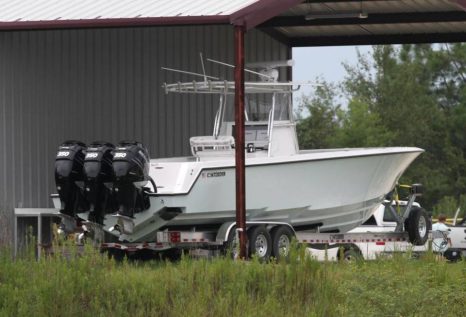
Why Mississippi DMR paid $291K for a boat fishermen dream of
This is not Bill Walker’s Department of Marine Resources. The DMR just bought a 39-foot, offshore boat, but it won’t be used for the legislative fishing trips, fishing tournaments and birthday outings that Bill Walker sanctioned under his regime, Executive Director Jamie Miller told the Sun Herald. DMR intends to use the boat for collecting finfish samples offshore, most notably red snapper, Miller said when the Sun Herald interviewed him this week at the DMR’s reef staging site on the Industrial Seaway, where the boat is stored. Miller said the DMR wants hard data to prove what most offshore fishermen will already tell you: Red snapper are more plentiful than the federal government’s stingy fishing limits indicate. (Oh, and one other thing. Miller said the boat “absolutely” will be used in undercover operations to nab fishermen with illegal catches. The Contender will be marked as a DMR boat, but its 70-mph top speed means enforcers will be on top of those fishing illegally before they can dispose of their catches.) Video, Read the story here 14:32
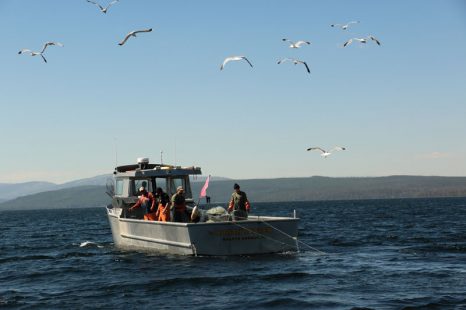
Commercial Fishing in Yellowstone National Park – Killing one fish to save another
White-breasted gulls are following a slow-moving boat in Yellowstone Lake. The crew on board is up to something fishy. It’s four fishermen letting out an awful lot of net. The net sinks into the lake’s deep depths in a large S-curve created by the swerve of the captain’s turns. The crew manages up to 40 miles of netting. That netting collects 300,000 lake trout every summer. “We are aggressively netting non-native lake trout in Yellowstone Lake to reduce their predation on our native cutthroat,” says Todd Koel, Yellowstone National Park native fish conservation leader. An angler turned in an unusual catch in 1994. It was a fish that wasn’t supposed to be in Yellowstone Lake — a lake trout. The surprise catch hooked biologists with an unexpected problem. They had an invader in a fishery carefully monitored for the persistence of the park’s coveted native fish, Yellowstone cutthroat trout. Read the story here 13:33
Community Supported Fishery’s – Membership-driven fishery starts taking orders
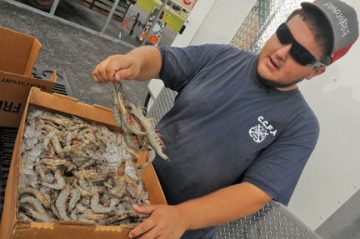 A new community-supported fishery has opened in Carteret County, with a focus on providing seafood to local residents and visitors. On Aug. 27, Taylor Chadwick, a commercial fisherman from Beaufort and owner of Chadwick’s Seafood, officially began his own community-supported fishery. This type of fishery operates by having customers sign up for a membership and participating fishermen provide locally caught seafood to the members. An example of one such fishery, which was also started in Carteret County, is Walking Fish, but while that community fishery charges a monthly fee for its seafood and focuses on inland sales, Mr. Chadwick’s fishery charges for individual purchases and focuses on the local seafood market. According to the fishery’s website, chadwickseafood.com, the fishery will operate from March to December. Mr. Chadwick said members who sign up on the website may start placing orders for seafood on Monday. Read the story here 12:46
A new community-supported fishery has opened in Carteret County, with a focus on providing seafood to local residents and visitors. On Aug. 27, Taylor Chadwick, a commercial fisherman from Beaufort and owner of Chadwick’s Seafood, officially began his own community-supported fishery. This type of fishery operates by having customers sign up for a membership and participating fishermen provide locally caught seafood to the members. An example of one such fishery, which was also started in Carteret County, is Walking Fish, but while that community fishery charges a monthly fee for its seafood and focuses on inland sales, Mr. Chadwick’s fishery charges for individual purchases and focuses on the local seafood market. According to the fishery’s website, chadwickseafood.com, the fishery will operate from March to December. Mr. Chadwick said members who sign up on the website may start placing orders for seafood on Monday. Read the story here 12:46
Outlook improves for Dungeness crab season
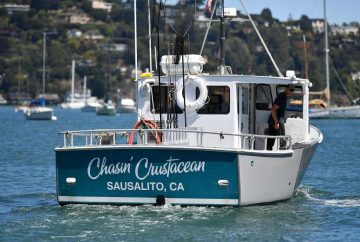 Even though last year’s “blob” of warm water finally dissipated, no one is resting easy — especially after the California Department of Public Health issued an advisory in August against eating rock crab from Half Moon Bay and Monterey Bay after the crustacean tested high for domoic acid. Government agencies and legislators are trying to streamline the process of opening and closing fisheries for the crab season, so that areas that stay free of algal blooms can remain open even if other areas have to close, keeping more safe crab on the table and fishers in business. “We’re cautiously optimistic that we won’t see the widespread pervasive domoic acid levels that are above health alert levels,” said Craig Shuman, marine region manager of the California Department of Fish and Wildlife, who said that safety testing on Dungeness crab will start this month, which is earlier than usual. Read the story here 12:05
Even though last year’s “blob” of warm water finally dissipated, no one is resting easy — especially after the California Department of Public Health issued an advisory in August against eating rock crab from Half Moon Bay and Monterey Bay after the crustacean tested high for domoic acid. Government agencies and legislators are trying to streamline the process of opening and closing fisheries for the crab season, so that areas that stay free of algal blooms can remain open even if other areas have to close, keeping more safe crab on the table and fishers in business. “We’re cautiously optimistic that we won’t see the widespread pervasive domoic acid levels that are above health alert levels,” said Craig Shuman, marine region manager of the California Department of Fish and Wildlife, who said that safety testing on Dungeness crab will start this month, which is earlier than usual. Read the story here 12:05
Marlborough Sounds Blue Cod fishing ban has been branded “insane” by fishermen
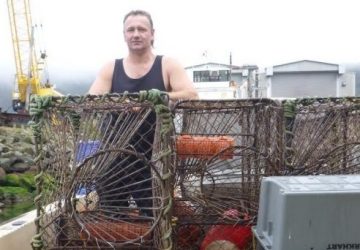 A ban on commercial blue cod fishing in the Marlborough Sounds has been branded “insane” by fishermen who will be out of work for the next four months. The Ministry for Primary Industries closed the Sounds to commercial blue cod fishers for the first time on Thursday. The season closure will run until December 20. Fisherman Kelly Aldridge said the ban meant he could not fish in an area which comprised 85 per cent of his fishing ground, in the outer Sounds. It was effectively putting him out of work until Christmas. “My boat’s not big enough to travel further afield,” he said. Commercial fishermen could normally catch blue cod in the Sounds all year, while the area was closed to recreational fishers from September 1 to December 20. Read the story here 11:06
A ban on commercial blue cod fishing in the Marlborough Sounds has been branded “insane” by fishermen who will be out of work for the next four months. The Ministry for Primary Industries closed the Sounds to commercial blue cod fishers for the first time on Thursday. The season closure will run until December 20. Fisherman Kelly Aldridge said the ban meant he could not fish in an area which comprised 85 per cent of his fishing ground, in the outer Sounds. It was effectively putting him out of work until Christmas. “My boat’s not big enough to travel further afield,” he said. Commercial fishermen could normally catch blue cod in the Sounds all year, while the area was closed to recreational fishers from September 1 to December 20. Read the story here 11:06

Post-Tropical Cyclone HERMINE Public Advisory
At 800 AM EDT (1200 UTC), the center of Post-Tropical Cyclone Hermine was located near latitude 37.0 North, longitude 70.0 West. The post-tropical cyclone is moving toward the east-northeast near 12 mph (19 km/h). A turn toward the northeast and the north with a decrease in forward speed is expected later today, followed by a slow northward to northwestward motion through Monday. On the forecast track, the center of Hermine will meander slowly offshore of the mid-Atlantic coast for the next couple of days. Maximum sustained winds are near 65 mph (100 km/h) with higher gusts. Little change in strength is expected today. After that, the cyclone is forecast to intensify to hurricane force late tonight and on Monday. Hermine has a large wind field. Tropical-storm-force winds extend outward up to 205 miles (335 km) from the center. Read the rest here 09:56
Commercial F/V Sweet Marie rescues 26 passengers from grounded charter boat in Mexican waters
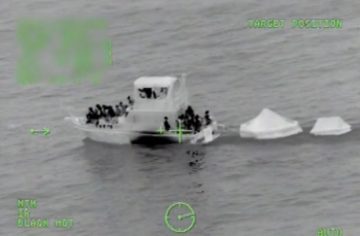 More than two dozen people on board a 63-foot sport-fishing boat were rescued in Mexican waters Saturday morning near the Coronado Islands southwest of San Diego, according to authorities. The U.S. Coast Guard Sector San Diego Joint Harbor Operations Center heard the call for help at about 5 a.m. that the American-flagged vessel Invicta had crashed into rocks. The Invicta was reported to be taking on water while it was anchored and the crew were deploying their life rafts, according to Coast Guard officials. Five crewmembers and 21 passengers were on board. The crew of the 35-foot commercial fishing vessel Sweet Marie overheard the calls for help and diverted to assist the Invicta, the Coast Guard said. Sweet Marie’s crew arrived on scene and safely transported all 26 passengers and crewmembers aboard their vessel and began to make way toward San Diego. Read the story here Watch video here 08:48
More than two dozen people on board a 63-foot sport-fishing boat were rescued in Mexican waters Saturday morning near the Coronado Islands southwest of San Diego, according to authorities. The U.S. Coast Guard Sector San Diego Joint Harbor Operations Center heard the call for help at about 5 a.m. that the American-flagged vessel Invicta had crashed into rocks. The Invicta was reported to be taking on water while it was anchored and the crew were deploying their life rafts, according to Coast Guard officials. Five crewmembers and 21 passengers were on board. The crew of the 35-foot commercial fishing vessel Sweet Marie overheard the calls for help and diverted to assist the Invicta, the Coast Guard said. Sweet Marie’s crew arrived on scene and safely transported all 26 passengers and crewmembers aboard their vessel and began to make way toward San Diego. Read the story here Watch video here 08:48

Video Update: Coast Guard rescues 3 fishermen and a dog from disabled vessel near Wachapreague, Va
The Coast Guard rescued three fishermen and a dog Saturday after their vessel became disabled and ran aground two miles off Wachapreague Inlet. Watchstanders in the Coast Guard Sector Hampton Roads Command Center in Portsmouth received notification at 2:42 a.m. Saturday that the 60-foot commercial fishing vessel Storm was soft aground near Wachapreague Inlet with three people and a dog aboard. The vessel freed itself, however two hours later the crew discovered serious damage to the rudder along with flooding. A 47-foot Motor Life Boat (MLB) crew launched from Coast Guard Station Chincoteague at 4:47 a.m. and made way toward the scene in 12-15 foot seas, arriving at 8:18 a.m. The MLB crew found Storm adrift with no way to steer the vessel. The MLB crew assessed the situation and determined a tow would not work due to the deck configuration of the fishing vessel and the sea state. The crew aboard Storm attempted to anchor the vessel to prevent it from drifting but were not successful due to the heavy weather. By this time the heavy seas made it too dangerous for a direct transfer of people between vessels. An MH-60 Jayhawk helicopter crew launched from Air Station Elizabeth City, North Carolina, at 12:23 p.m. The aircrew arrived on scene at 1:02 p.m., and hoisted all three people and their dog to the helicopter by 1:58 p.m. They were transported to Richmond International Airport, arriving at 2:30 p.m. Fishing vessel Storm remains unmanned and adrift with an activated EPIRB aboard and all navigational lights energized. Link Watch the video here 08:07
Two Hundred Million Dollar Scientific Grant Fraud Case against Duke University
 Federal Prosecutors have launched a gigantic fraud case against Duke University, North Carolina, accusing Duke University of embezzling $200 million in federal research grants, by presenting doctored data with their grant applications. – On a Friday in March 2013, a researcher working in the lab of a prominent pulmonary scientist at Duke University in Durham, North Carolina, was arrested on charges of embezzlement. The researcher, biologist Erin Potts-Kant, later pled guilty to siphoning more than $25,000 from the Duke University Health System, buying merchandise from Amazon, Walmart, and Target—even faking receipts to legitimize her purchases. A state judge ultimately levied a fine, and sentenced her to probation and community service. Then Potts-Kant’s troubles got worse. Read the rest here 13:03
Federal Prosecutors have launched a gigantic fraud case against Duke University, North Carolina, accusing Duke University of embezzling $200 million in federal research grants, by presenting doctored data with their grant applications. – On a Friday in March 2013, a researcher working in the lab of a prominent pulmonary scientist at Duke University in Durham, North Carolina, was arrested on charges of embezzlement. The researcher, biologist Erin Potts-Kant, later pled guilty to siphoning more than $25,000 from the Duke University Health System, buying merchandise from Amazon, Walmart, and Target—even faking receipts to legitimize her purchases. A state judge ultimately levied a fine, and sentenced her to probation and community service. Then Potts-Kant’s troubles got worse. Read the rest here 13:03
The European green crab invades Washington State inland waters.
Earlier this week in Westcott Bay, San Juan Island, a team of volunteer monitors caught an invasive green crab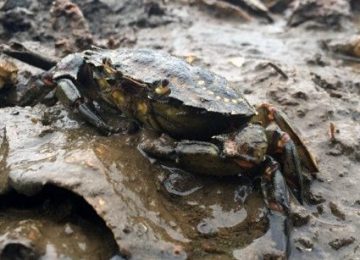 , marking the first confirmation of this global invader in Washington’s inland waters. The volunteers are part of Washington Sea Grant’s Crab Team, an early detection and monitoring program to look for European green crab (Carcinus maenas) and collect information on local marine life. Washington Department of Fish and Wildlife is responsible for controlling aquatic invasive animals. European green crab have been stowaways on ships bound for U.S. ports since the 1800s, establishing populations, eating local clams and other shellfish and causing serious impacts. In Maine, for example, softshell clam harvests declined dramatically when the crab became established and eelgrass beds have been damaged by the invader’s digging habits. Read the story here 12:25
, marking the first confirmation of this global invader in Washington’s inland waters. The volunteers are part of Washington Sea Grant’s Crab Team, an early detection and monitoring program to look for European green crab (Carcinus maenas) and collect information on local marine life. Washington Department of Fish and Wildlife is responsible for controlling aquatic invasive animals. European green crab have been stowaways on ships bound for U.S. ports since the 1800s, establishing populations, eating local clams and other shellfish and causing serious impacts. In Maine, for example, softshell clam harvests declined dramatically when the crab became established and eelgrass beds have been damaged by the invader’s digging habits. Read the story here 12:25
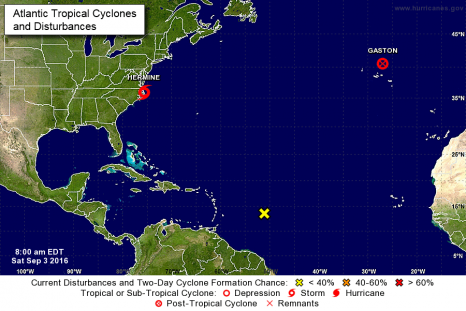
Tropical Storm Hermine, center moves over water, could be near hurricane intensity by Sunday
A Fish And Wildlife Seat Up For Grabs, With High Stakes
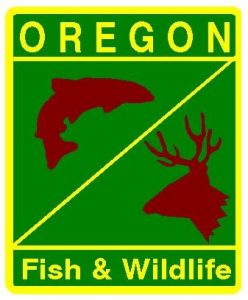 Openings on the Oregon Fish and Wildlife Commission have sport fishing groups eyeing an opportunity to gain a voice while some environmental groups worry they’ll lose one. Two members are up for reappointment and another seat is vacant on the commission, which sets natural resource policies ranging from hunting and fishing rules to last year’s decision to remove gray wolves from the endangered list. Recreational anglers hope one of their longtime advocates, Liz Hamilton, can become one of the seven members of the commission, which they say has tilted too far toward commercial fishing interests. Hamilton runs the Northwest Sportfishing Industry Association. She submitted a letter of interest to Oregon Gov. Kate Brown earlier this summer expressing her interest in joining the commission. It included endorsements from Sen. Ron Wyden and Reps. Earl Blumenauer and Kurt Schrader, along with several prominent figures from the sport fishing community. Environmental groups are supporting the reappointment of Greg Wolley, who they consider one of the commission’s strongest voice for conservation. He is also the first and only African-American member of the commission. Read the story here 10:14
Openings on the Oregon Fish and Wildlife Commission have sport fishing groups eyeing an opportunity to gain a voice while some environmental groups worry they’ll lose one. Two members are up for reappointment and another seat is vacant on the commission, which sets natural resource policies ranging from hunting and fishing rules to last year’s decision to remove gray wolves from the endangered list. Recreational anglers hope one of their longtime advocates, Liz Hamilton, can become one of the seven members of the commission, which they say has tilted too far toward commercial fishing interests. Hamilton runs the Northwest Sportfishing Industry Association. She submitted a letter of interest to Oregon Gov. Kate Brown earlier this summer expressing her interest in joining the commission. It included endorsements from Sen. Ron Wyden and Reps. Earl Blumenauer and Kurt Schrader, along with several prominent figures from the sport fishing community. Environmental groups are supporting the reappointment of Greg Wolley, who they consider one of the commission’s strongest voice for conservation. He is also the first and only African-American member of the commission. Read the story here 10:14
Fishermen rescued after commercial fishing boat capsizes
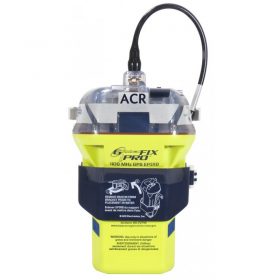 Two men have been rescued after their fishing boat flipped just south of the Chatham Islands. They were picked up 1.8 kilometres south of Pitt Island after activating their distress beacon on Saturday morning. The crew of the 11-metre commercial fishing vessel Flynny set off their beacon around 11.30am and the signal was received by the Rescue Coordination Centre New Zealand (RCCNZ). Another local fishing boat The Eclipse was directed to the scene and found the men sitting on the upturned hull. They were reported safe and sound around 11.40am. RCCNZ search and rescue mission coordinator Chris Wilson said the area was known as “a blackspot” for VHF radio and the beacon signal was essential to raise the alarm. Read the rest here 09:51
Two men have been rescued after their fishing boat flipped just south of the Chatham Islands. They were picked up 1.8 kilometres south of Pitt Island after activating their distress beacon on Saturday morning. The crew of the 11-metre commercial fishing vessel Flynny set off their beacon around 11.30am and the signal was received by the Rescue Coordination Centre New Zealand (RCCNZ). Another local fishing boat The Eclipse was directed to the scene and found the men sitting on the upturned hull. They were reported safe and sound around 11.40am. RCCNZ search and rescue mission coordinator Chris Wilson said the area was known as “a blackspot” for VHF radio and the beacon signal was essential to raise the alarm. Read the rest here 09:51

Good news for fishermen. FDA Bans Antibacterial Triclosan in soap.
Antibacterial soaps were banned from the US market on Friday in a final ruling by the Food and Drug Administration, which said that manufacturers had failed to prove the cleansers were safe or more effective than normal products. The new federal rule applies to any soap or antiseptic product that has one or more of 19 chemical compounds, including triclocarbon, which is often found in bar soaps, and triclosan, often in liquid soaps. Professor Patrick McNamara: triclosan could play a part in driving antibiotic resistance, saying, “after these chemicals are used in our homes they go down the drain to wastewater treatment plants and eventually to the environment where they can select for antibiotic resistance genes”. Read the article here American Style Environmentalism is Destroying The Environment Part 1 by JJ Johnson written May 8, 2012 – Dawn dishwashing liquid (distributed by Proctor and Gamble) has a wildlife campaign that is advertised on the bottles of soap. The bottles proudly proclaim, “Dawn Helps Save Wildlife,” and feature heart warming pictures of ducks, penguins, and even two seals kissing (My personal favorite.) Read the article here 08:50
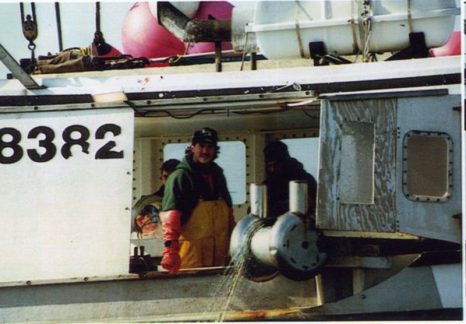
In Remembrance – Recalling the Heather Lynne II
Sometime before dawn on Sept. 5, 1996, the Heather Lynne II — a 45-foot fishing boat out of Newburyport — capsized off the coast of Cape Ann when it struck a long cable connecting a 272-foot barge to the tugboat it was towing, Capt. Jeffrey Hutchins and his two-man crew of Kevin Foster and John Michael Lowther were trapped, but alive, for some time in the overturned hull of the Heather Lynne II, 10 miles off Gloucester. A diminishing air pocket kept the boat from sinking and provided hope of survival for the three fishermen trapped inside. Their shouted pleas and desperate tapping could be heard by would-be rescuers who began to gather around them. But as boats came to the ship’s aid, they were directed to wait for the Coast Guard and a dive team to conduct the rescue effort. By the time the Coast Guard arrived, the three fishermen had drowned, leaving their families heartbroken and leading to an investigation of the Coast Guard’s conduct and delayed response in the rescue. Twenty years later, many who knew the lost crew of the Heather Lynne II still feel the pain, in part because it is unclear exactly what took place after the pre-dawn collision. Read this story here with images 07:13
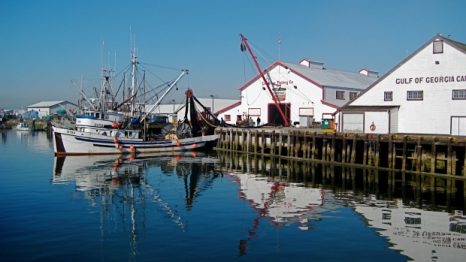
Ottawa investing $33.5M in British Columbia harbour improvement projects
The federal government announced it will invest $33.5 million to carry out harbour improvement projects — including wharf construction, maintenance and dredging — at 29 small harbours throughout B.C. “Small craft harbours are the hub for our fishing industry,” said Joe Peschisolido, Liberal MP for Steveston-Richmond, who announced the funding on Aug. 31. “Fish is actually now our second most important food export after wheat, and creates a lot of economic activity. If you want to create wealth … you want to have an efficient economy, you need infrastructure and small craft harbours are an integral part of our infrasturure. Almost a third of that funding will go to the Steveston Harbour Authority in Richmond, which serves over 500 commercial fishing vessels. Read the story here 16:12
Obama brings fresh attention to an expanded marine sanctuary (and the fishermen it hurts)
 Yesterday, while visiting Hawaii’s Midway Atoll, President Obama officially made the size of a marine monument twice the size of Texas while highlighting his Climate Change commitment. The monument’s new size has angered local fishermen and Native Hawaiians. The monument, created by President George W. Bush in 2006, puts more land and waters off limits to local fishermen and recreation, and Obama’s critics are calling his actions heavy-handed. The monument is now the largest protected marine Environment in the world or roughly 3.5 times the size of California. A native of Hawaii, Obama used his executive power to expand the Papahānaumokuākea Marine National Monument, making large swaths of fertile fishing grounds off-limits to fishermen. That means they now have to travel at least four times further out to sea to catch fish like tuna, a costly adventure that actually emits more greenhouse gas emissions because of the increased travel time. Hawaiians not only consume three times more fish than landlocked Americans but fishing is a major source of local commerce. Read the rest here 15:03
Yesterday, while visiting Hawaii’s Midway Atoll, President Obama officially made the size of a marine monument twice the size of Texas while highlighting his Climate Change commitment. The monument’s new size has angered local fishermen and Native Hawaiians. The monument, created by President George W. Bush in 2006, puts more land and waters off limits to local fishermen and recreation, and Obama’s critics are calling his actions heavy-handed. The monument is now the largest protected marine Environment in the world or roughly 3.5 times the size of California. A native of Hawaii, Obama used his executive power to expand the Papahānaumokuākea Marine National Monument, making large swaths of fertile fishing grounds off-limits to fishermen. That means they now have to travel at least four times further out to sea to catch fish like tuna, a costly adventure that actually emits more greenhouse gas emissions because of the increased travel time. Hawaiians not only consume three times more fish than landlocked Americans but fishing is a major source of local commerce. Read the rest here 15:03
Judge Lets East Sand Island Cormorant Cull Continue
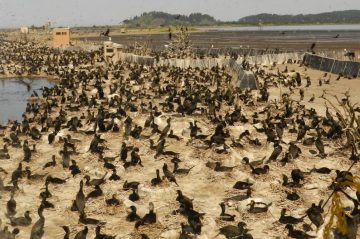 A federal judge will allow the Army Corps of Engineers to keep shooting native cormorants by the thousands, to reduce predation on young salmon, despite objections from environmentalists who say the slaughter doesn’t address the real cause of dwindling salmon populations: hydroelectric dams. The Audubon Society of Portland led an April 2015 lawsuit against the Corps of Engineers and the U.S. Fish & Wildlife Service, claiming that the plan scapegoated a natural predator and had little effect on survival rates of young salmon. Chief among the Audubon Society’s arguments is that there are so many factors that determine whether a salmon will return from sea to spawn in its native waters that the government’s focus on cormorant predation was not only fruitless, but hurt a native bird protected by the Migratory Species Act. The government’s plan focused on East Sand Island, home to the largest breeding population of double-crested cormorants in North America. The 60-acre island is nestled in the fertile brackish waters where the Columbia River empties into the Pacific Ocean. Read the rest here 14:11
A federal judge will allow the Army Corps of Engineers to keep shooting native cormorants by the thousands, to reduce predation on young salmon, despite objections from environmentalists who say the slaughter doesn’t address the real cause of dwindling salmon populations: hydroelectric dams. The Audubon Society of Portland led an April 2015 lawsuit against the Corps of Engineers and the U.S. Fish & Wildlife Service, claiming that the plan scapegoated a natural predator and had little effect on survival rates of young salmon. Chief among the Audubon Society’s arguments is that there are so many factors that determine whether a salmon will return from sea to spawn in its native waters that the government’s focus on cormorant predation was not only fruitless, but hurt a native bird protected by the Migratory Species Act. The government’s plan focused on East Sand Island, home to the largest breeding population of double-crested cormorants in North America. The 60-acre island is nestled in the fertile brackish waters where the Columbia River empties into the Pacific Ocean. Read the rest here 14:11
Yes, I butcher whales. It’s certainly no worse than what happens in slaughterhouses
 I ( Heri Joensen ) live in the Faroe Islands, where whaling has been part of our way of life for centuries. Last month, I was working on a long-finned pilot whale the day after it had been killed. Since more than four-fifths of the world’s population eats meat, I thought it would be fine to share such a picture — it’s no secret, surely, how meat is produced? But uproar followed. A campaign was launched to cancel my band’s (Týr) gigs and stop venues booking us. We seldom see pictures from inside slaughterhouses. As a result, people have strange ideas about meat — they seem to believe that animals are willingly and painlessly slaughtered behind closed doors. Ethically, I don’t see the difference between slaughtering wild whales and farmed cows. All animals suffer: if you can slaughter cows for meat, why not slaughter wildlife? Video, Read the story here 12:37
I ( Heri Joensen ) live in the Faroe Islands, where whaling has been part of our way of life for centuries. Last month, I was working on a long-finned pilot whale the day after it had been killed. Since more than four-fifths of the world’s population eats meat, I thought it would be fine to share such a picture — it’s no secret, surely, how meat is produced? But uproar followed. A campaign was launched to cancel my band’s (Týr) gigs and stop venues booking us. We seldom see pictures from inside slaughterhouses. As a result, people have strange ideas about meat — they seem to believe that animals are willingly and painlessly slaughtered behind closed doors. Ethically, I don’t see the difference between slaughtering wild whales and farmed cows. All animals suffer: if you can slaughter cows for meat, why not slaughter wildlife? Video, Read the story here 12:37
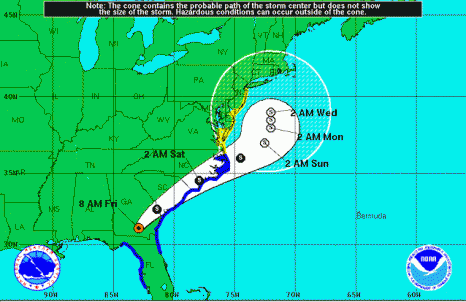
National Hurricane Center: Tropical Storm Hermine Projected Path Update 8 AM
NOAA’s National Hurricane Center in Miami, Florida issued a Public Advisory at 8 a.m. EDT on Friday, September 2, 2016, for Tropical Storm Hermine that made landfall on Florida and now threatens the U.S. east coast. A Tropical Storm Watch has also been issued for the United States east coast from Duck, North Carolina to Sandy Hook, New Jersey, including Chesapeake Bay from Smith Point southward and southern Delaware Bay. Interests along the United States northeast coast should monitor the progress of this tropical cyclone. Projected Path Tropical Storm Hermine is located about 120 miles west-southwest of Savannah Georgia, and is moving to the north-northeast at 14 mph. NHC forecasters believe that the tropical cyclone will continue north-northeastward through Friday and Saturday. On the forecast track, the center of Tropical Storm Hermine will move across southeastern Georgia today, move across the coastal Carolinas tonight and move offshore of the North Carolina coast on Saturday. Link 12:07
We import 92% of our seafood. No wonder Something’s fishy about dismal San Diego seafood sales
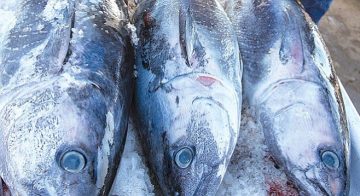 San Diegans could be eating more locally caught fresh fish, snails, squid, and lobsters, says a new study by academics from the Scripps Institution of Oceanography and USD, but globalization and a lack of reliable information about where the region’s edible seafood actually comes from is getting in the way. A total of 86 seafood markets served the city of San Diego’s 1.3 million residents in the first half of 2015,” says the August 29 paper in the Future of Food: Journal on Food, Agriculture and Society. “Only 8% of seafood markets consistently carried San Diego–sourced seafood, while 14% carried it on occasion, or at least likely did.” Worse yet, “None of the ethnic markets and only 7% of large chain stores carried San Diego–sourced seafood; these two market types comprised 72% of all seafood markets in San Diego.” Read the story here 11:31
San Diegans could be eating more locally caught fresh fish, snails, squid, and lobsters, says a new study by academics from the Scripps Institution of Oceanography and USD, but globalization and a lack of reliable information about where the region’s edible seafood actually comes from is getting in the way. A total of 86 seafood markets served the city of San Diego’s 1.3 million residents in the first half of 2015,” says the August 29 paper in the Future of Food: Journal on Food, Agriculture and Society. “Only 8% of seafood markets consistently carried San Diego–sourced seafood, while 14% carried it on occasion, or at least likely did.” Worse yet, “None of the ethnic markets and only 7% of large chain stores carried San Diego–sourced seafood; these two market types comprised 72% of all seafood markets in San Diego.” Read the story here 11:31
Test fishing for flounder begins off Fukushima coast
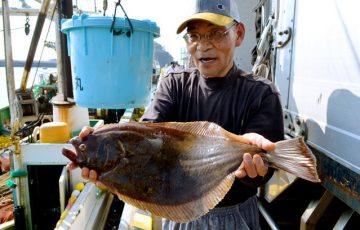 Fishermen here caught flounder for sales on Sept. 2 for the first time since the 2011 disaster at the Fukushima No. 1 nuclear plant. Eleven boats equipped with dragnets left Hisanohama wharf in the morning, and they snared five of the bottom-dwelling flatfish, previously a specialty of Fukushima Prefecture. “It is a big step (for flounder fishing),” said Akira Egawa, 69, head of the Iwaki city fishery association. “We are going to recover one by one.” On Aug. 25, 10 kinds of fish, including flounder, were added to the list for “test fishing” off the coast of Fukushima Prefecture. These fish can be caught for the resumption of sales of “safe” fish. In 2010, 734 tons of flounder were caught in Fukushima Prefecture, the third most in Japan. Link 09:47
Fishermen here caught flounder for sales on Sept. 2 for the first time since the 2011 disaster at the Fukushima No. 1 nuclear plant. Eleven boats equipped with dragnets left Hisanohama wharf in the morning, and they snared five of the bottom-dwelling flatfish, previously a specialty of Fukushima Prefecture. “It is a big step (for flounder fishing),” said Akira Egawa, 69, head of the Iwaki city fishery association. “We are going to recover one by one.” On Aug. 25, 10 kinds of fish, including flounder, were added to the list for “test fishing” off the coast of Fukushima Prefecture. These fish can be caught for the resumption of sales of “safe” fish. In 2010, 734 tons of flounder were caught in Fukushima Prefecture, the third most in Japan. Link 09:47

































